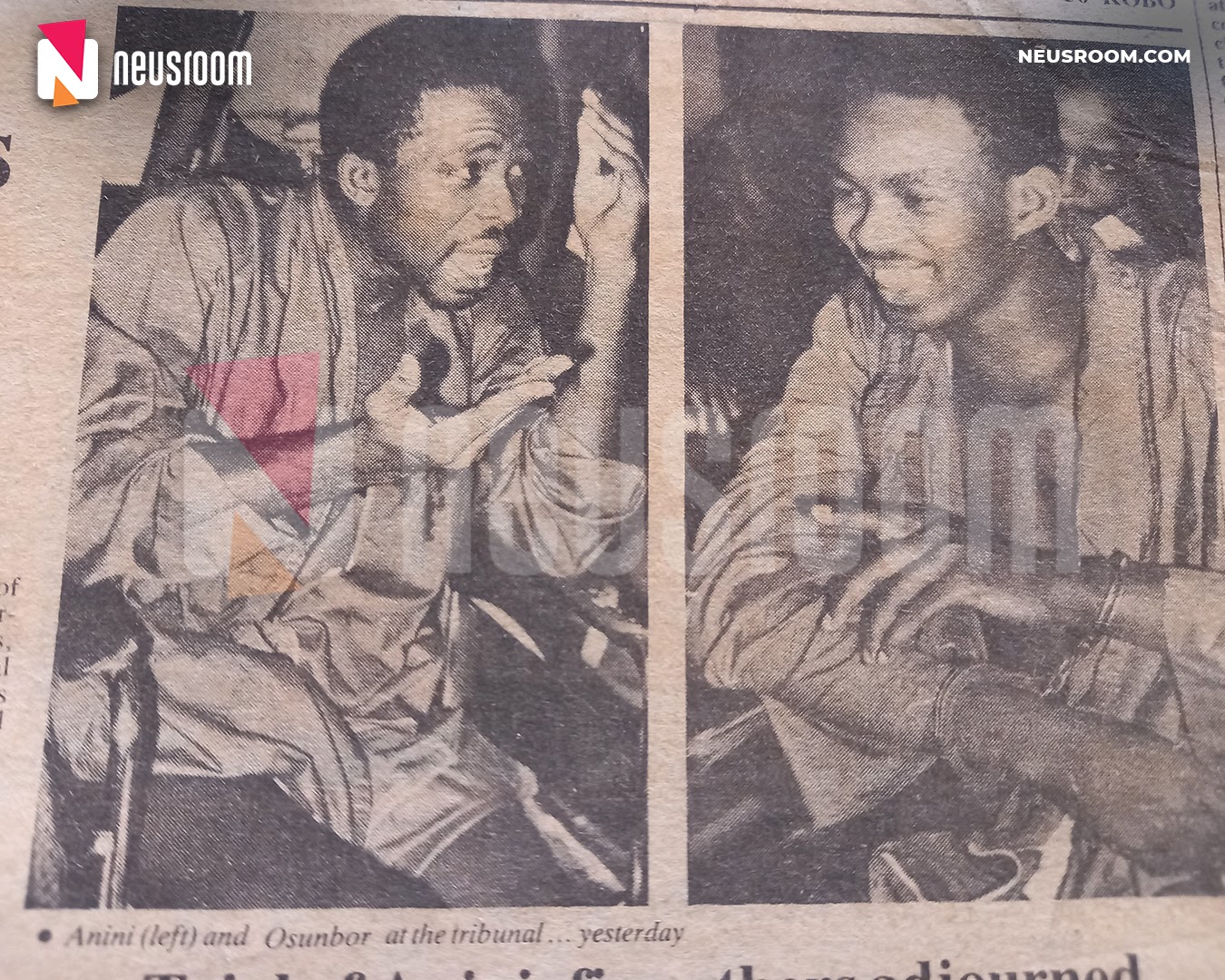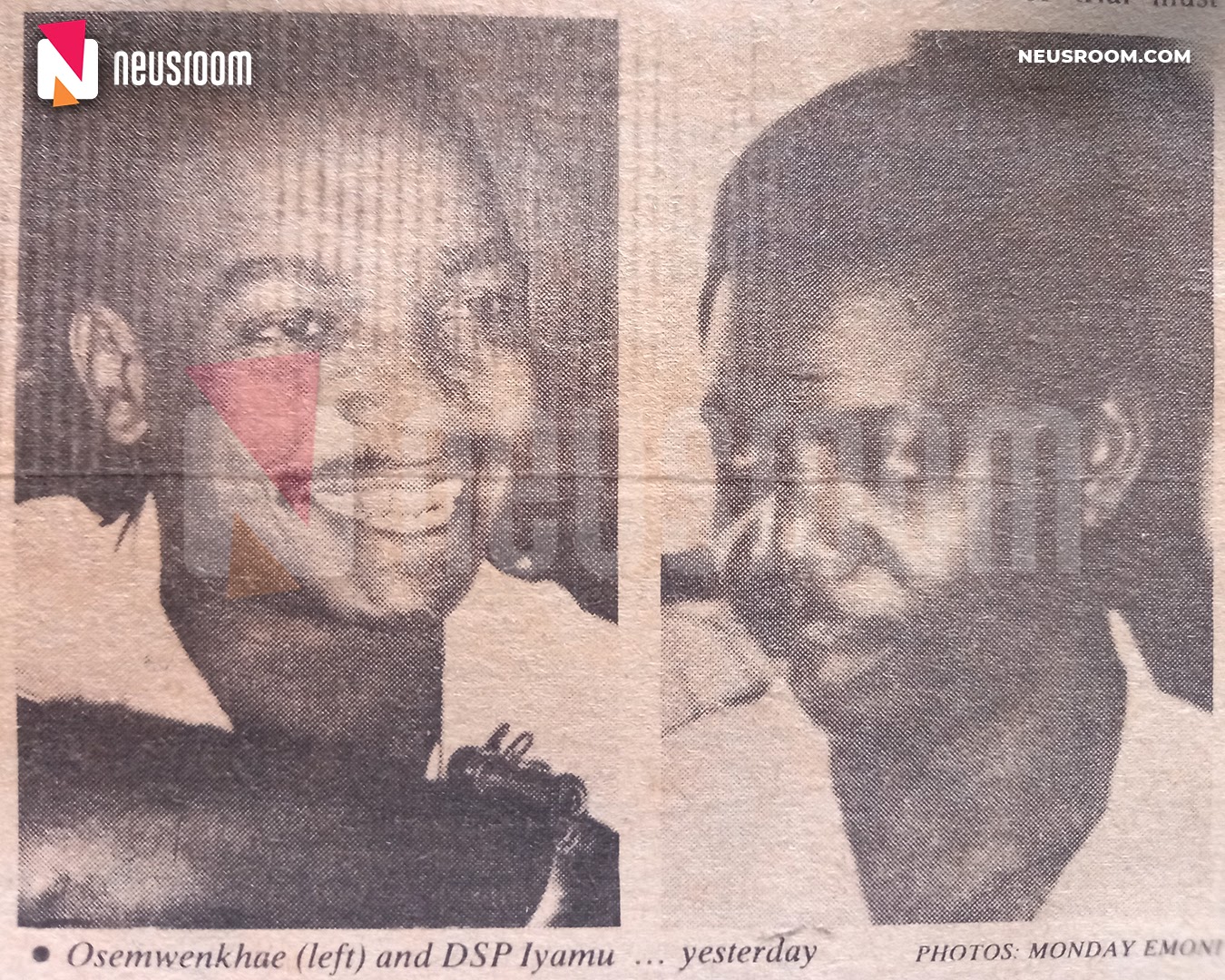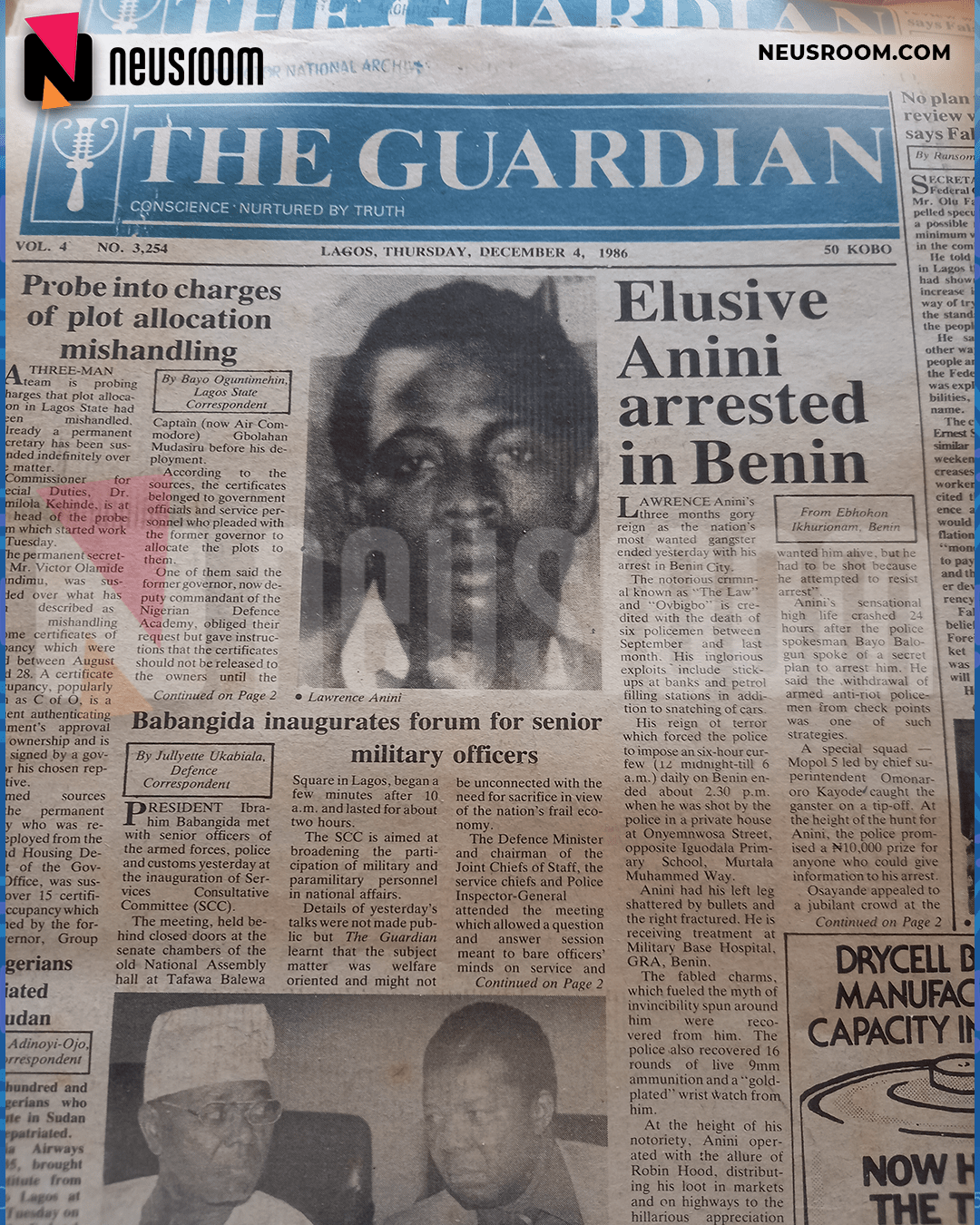Kingpins: The Story of Nigeria’s most Notorious Armed Robbers : Episode 6 – Lawrence Anini
Lawrence Anini – the 26-year-old notorious robber who terrorized Nigeria

Lawrence Anini – the 26-year-old notorious robber who terrorized Nigeria
Written by Michael Orodare for Neusroom
Additional reporting by Folayan Adejoke
15 April 2021
“Anini will forever be remembered in the history of crime in this country, but it would be of unblessed memory,” that was the pronouncement of Justice James Omo-Agege when he sentenced Lawrence Anini to death after reading the 33-page judgment which took 80 minutes to deliver.
In the early 1980s, Anini, popularly known as ‘The Law’, carried out some of the most brutish robbery attacks in the history of Nigeria, and replicated them with increasing sophistication, brazenness, and arrogance that dwarfed the atrocities of many before him.
Although he confined his atrocities to Bendel State (present-day Edo and Delta states) and environs, Anini was a serious national security issue and an embarrassment to the Nigeria Police Force. Spearheading a reign of terror that reached a crescendo between August and December 1986, he killed at will, robbed, raped, and kidnapped, daring the top echelon of the Police Force by attacking the convoy of a police commissioner and an Assistant Inspector General of Police.
His reign of terror forced The Guardian Nigeria to ask in one of its editorials – “Will they ever find Anini, ‘The Law’?’”
His reign popularised a saying across the nation at the time that of the 19 states in Nigeria, Anini possessed three – Ondo, Anambra, and Bendel.
Neusroom recently chased down stories on Anini from the National Archive, University of Ibadan, about 140km up north Lagos, and visited the house where he was arrested in 1986 in Benin city, about 320km away from Lagos.
What we found is laid bare in this previously untold story of ‘The Law’, acclaimed to be the most notorious in Nigeria’s crime history.
The Man Lawrence Anini

Anini and Monday Osunbor, his second in command, faced the military tribunal in 1986. Photo: National Archive/The Guardian newspaper..
Born Lawrence Nomayagbon Anini in 1960, he was from Orogho village (Orhionmwon Local Government Area) about 100km away from Benin city. The second child and only son of his mother Madam Akuguehia Oghadomwangbe’s three children, it was later revealed that his father who died in 1980 had a son with another woman.
When Anini moved to Benin City, his dream was to become a driver. He learnt how to drive and started driving a taxi in the city. Despite being very young, at the motor park, his word was law. And he became known for resolving motor park crises.
He soon channeled his driving skills into crime, becoming the official driver for Benin bandits. After learning the ropes, he formed his own gang made up of Monday Osunbor (his second-in-command), Solomon Osemwenkhae, Johnbull Ahuwan, Moses Idahosa, Philip Iwebelua, Bernard Obi, and Friday Ukponwan. They specialised in carjacking and bank robbery. On his payroll was a police officer, DSP George Iyamu, who aided the gang’s operations with security information.
Charles Enonchong, the author of ‘The Rise and Fall of Anini’, described Anini as a lover of nice clothes and a chain-smoker.
“He particularly enjoyed wearing impeccably tailored suits. A spendthrift and womanizer,” he wrote. “But there was also a hidden coward in him. For that reason, to bolster his courage, he took refuge in alcohol, marijuana, and a menagerie of charms which all inspired the beast in him.”
His Acts of Terror
In our month-long research and travels, including a visit to the National Archive where we assessed and analysed newspaper publications for more than three hours, we found reports saying Anini’s criminal career started in the early 1980s and reached a crescendo between August and December 1986 when he finally met his comeuppance. Residents of Bendel and neighbouring states lived in fear and panic while Anini and his men had a free reign. The media named him the “Outlaw King of Benin”.
In August 1986, Anini and his gang raided First Bank, Sabongida-Ora, in Edo State. They stole $2,000. A dollar exchanged for N5 in 1986. Converted at today’s exchange rate (N480), what Anini and his gang stole 34 years ago would be equivalent to around N190,000.
On October 21, 1986, after stealing N46,000 from the Agbor branch of African Continental Bank, Anini drove into a nearby market and tossed part of his loot from his getaway car to passersby. This action which he reportedly replicated numerous times earned him the moniker ‘Robin Hood’, after a British folklore character who robbed the rich and shared proceeds with the poor.
Anini was brutal and policemen were his top victims. A total of 20 persons – 11 policemen and nine civilians were reportedly killed by Anini and his gang. Explaining his reason for unleashing terror on the men in uniform, This week magazine of December 15, 1986, seen by Neusroom, quoted Anini, who only expressed himself in pidgin English, as saying:
“I did not kill police. My own is to do my own. I am a driver, I drive. I always beg them not to kill policemen, not to kill people. My problem with the police is that them kill my father and my brother at Ibadan, and my friend Kingsley Eweka [a Benin Prince].”

DSP George Iyamu (right), the notorious policeman who aided Anini’s atrocities with security information. Photo: National Archive/The Guardian.
Anini’s Letters
Anini became so emboldened that he started writing letters to his potential victims to announce his planned visit. And he never failed to honour his words. At the said time and date, Anini visited.
In August 1986, Anini wrote a letter to the manager of the New Nigeria Bank, Ring Road branch, in Benin City, informing the bank that because he intended to visit anytime, “the sum of N10,000 should be set aside for him,” Charles Enonchong wrote in ‘The Rise and Fall of Anini’. “Anini gave his address as Number 1,000,000 Anywhere Street Within the City, Benin, Bendel State.”
Rather than report to the Police, the bank scurried to the Oba of Benin to report Anini’s letter to the traditional authority.
There was a wide belief in the city that the police could not be trusted. Many residents who may have aided the Police with information that could have facilitated Anini’s arrest also suspected that they may be accused of being accomplices or the police might send their names to Anini. Some even feared they could be killed.
At the height of Anini’s terror, the then Head of State Ibrahim Babangida challenged the Inspector- General of Police, Etim Inyang, and demanded Anini’s whereabouts after a meeting of the Armed Forces Ruling Council in October 1986.
“My friend, where is Anini?” Babangida asked the IGP.
In a letter he reportedly addressed to the Head of State in October 1986, Anini wrote “Tell our President, we like him but we are not happy here in Bendel. The payment for everything is too much. That is why I now divide any money I get to the people.”
Newswatch magazine in its October 27, 1986 publication listed the six conditions Anini gave for peace to return to Benin city.
“No more prosecution of innocent armed robbers; a stop to collusion between the police and the Nigerian Union of Road Transport Workers, and with members of the Ogboni cult; no more harassment of market women returning from their work; the ‘abolition of the collection of 50k-N5 [by the Highway Patrol] equal treatment for everybody; and fair treatment for all legitimate drivers by the police.”
From the tone and content of the letter, it would not be out of place to say he had positioned himself as an advocate for the NURTW (his former trade union) and the market women, and he didn’t fail to speak for his fellow criminals whom he described as ‘innocent armed robbers’.
His Arrest
In December 1986, Bendel heaved a sigh of relief from Anini’s reign of terror. After a heightened manhunt launched by the police, a 10-man team of crack policemen led by Superintendent of Police Kayode Omonaroro brought an end to his atrocities on December 3, 1986.
He was in his usual merriment mood in the company of ladies at No. 26, Oyemwosa Street, opposite Iguodala Primary School, Benin City, when Uanreroro, acting on a tip-off, invaded the house and apprehended him with very little resistance.

A February 2021 photo of the front view of 26, Oyemwosa street, where Anini was arrested in 1985.
According to multiple accounts, when the Police knocked on the door of the room, Anini himself opened it.
Asked “Where is Anini,” he tried to play smart. “Oh, Anini is under the bed in the inner room,” he responded and made swift moves to walk past Omonaroro and his team.
Omonaroro reached for his gun and shot at Anini’s left ankle. To render him incapacitated, the police opened fire on the leg. At that point, he knew it was over, asked again if he was Anini, he replied, “My brother, I won’t deceive you; I won’t tell you lie, I’m Anini.”
He was arrested and taken to the Police headquarters and transferred to the military hospital where he was treated and his injured leg amputated.
Neusroom’s search for information about the 16-year-old schoolgirl, Florence Akhoragie, who was shot in the thigh when Anini was arrested in 1986, was futile.
According to a December 5, 1986 publication of The Guardian Nigeria seen in the archives, Florence was one of the casualties of the encounter that led to Anini’s arrest and she was treated at the same hospital ward with Anini.
Over the years, several reports have misspelled the name of the Police officer who led the special squad – Mopol 5, that apprehended Anini as ‘Uanreroro’. Our visit to the archives revealed that he is Chief Superintendent Kayode Omonaroro. We searched the archives and the internet, but there is no information about Omonaroro.
How the Media reported Anini’s Arrest

The Guardian newspaper prominently reported Anini’s arrest on its front page on December 4, 1985. Photo: National Archive..
When he was finally captured in December 1986, the cover of Thisweek magazine ran a picture of the badly injured Anini in his hospital bed with the headline “Anini. Face to Face with The Law”.
The Guardian Nigeria, however, condemned the police’s approach in handling Anini’s arrest.
“Anini may have been a callous man…It is no reason why the police pumped six rounds of ammunition to blow off his leg. And instead of taking him to the hospital immediately, the police first took him to their office where they took their time,” The Guardian Nigeria editorial of December 13, 1986, read. “The state has the duty to protect even a notoriously bad man. It cannot be said that the force used on Anini was reasonable. It was patently brutal and unfortunate.”
A similar scenario played out 17 years after with the arrest of another notorious robber Abiodun Ogunjobi aka Godogodo in 2013. After driving him from Ibadan to Lagos with gunshot wounds, the police drove him to their office to jubilate and parade him before the media, with gunshot wounds, Godogodo was seen in multiple videos granting interviews to newsmen before he was taken to the hospital.
Asked by newsmen if he considered Anini’s capture to be the high point of his career, Commissioner of Police Parry Osayande replied:
“I can’t regard this as my finest hour. I have spent over 27 years in the Police Force. I have achieved a lot and will not regard the arrest of a common criminal as my greatest achievement.”
His Sentence and Execution

“I only threaten people for their money…I don’t shoot people…it is Monday (Osunbor) that kills.” the vicious Anini claims the atrocities credited to him were exaggerated. Photo: National Archive/The Guardian newspaper..
Justice James Omo-Agege, the Chairman of the First Benin Robbery and Firearms Tribunal which tried Anini, his gang, and DSP Iyamu, sentenced them to death in February 1987. On March 29, 1987, Anini was publicly executed along with Osunbor by firing squad. Members of his gang had been previously executed with DSP Iyamu.
During his larger-than-life era, Anini had predicted that his death would take place in one of the markets in Benin City. The population of people who witnessed his execution outnumbered the population that would have witnessed his death at the market.
The Associated Press (AP) reported that ″thousands of people from all walks in Bendel state today (March 29, 1987) watched the public execution of the notorious armed robbers Lawrence Anini and Monday Osunbor in Benin City.″
Moments before he was shot, Anini ″accepted responsibility for all the atrocities he committed against society and asked the Lord to forgive him,″ the AP reported.

The Guardian (Nigeria) newspaper’s editorial of December 1985 condemning the police approach in handling Anini’s arrest. Photo: National Archive/TheGuardian..
Following the many confessions of Anini and the revelation that he had an enabler in the police force, Godwin Etakibuebu author of ‘Anini: The Saga of an Armed Robber,’ questioned why the wife of the military governor of the defunct Bendel state Major General John Mark Inienger would send gifts to Anini while he was on the hospital bed after his arrest.
He wrote: “It is difficult however to understand the rationale behind the Governor’s wife’s (Mrs. Inienger) generosity to Lawrence Anini. It is on record that during the period of Christmas for 1986, she sent some gifts to Lawrence Anini on his hospital bed.”
“Why the armed robbery kingpin?” Etakibuebu wondered.
“Agreed that it has become a tradition where wives of Governors, like the wife of the Head of the Federal Government, send gifts to some selected people and institutions during Christmas as part of Christmas good wishes, must such gifts go to Anini.”
His Sentence and Execution
According to a 1986 publication of the African Guardian, Anini told newsmen that he fathered two children, Osaro and Emadiobogbe by his wife, Ugo.
He also claimed he was expecting a baby from a woman named Gladys, who left him and fled abroad.
In 1985, the police raided Anini’s village and arrested many of the villagers including his younger sister. His mother Madam Akuguehia Oghadomwangbe, who was also arrested but later released, told This week magazine in 1987 that she and other members of her family were subjected to all forms of torture in police detention.
Anini’s crimes left a stigma on his family and 34 years after his death, his children said they are still labelled as sons of a criminal whenever they walk on the street.

The old mud-plastered house where Anini was arrested in 1986 now wears a new look.
During a visit to the street in February 2021 by Neusroom, we found that the house which was deserted after Anini’s arrest has been renovated and painted yellow and green.
In 1986, Police Commissioner, Parry Osayande, had doused fears that the owner of the house would also be prosecuted. “The landlord has not committed any crime,” he said.
The house remains a bungalow on the untarred Onyemwosa street in Benin city.


Crime is evil
He didn’t impact anyone’s life not even his children.
Crime is not a good thing
He only collected by force caused if he asked politely they won’t give
At least he shared something with marketers… Well…. He also carried out vengeance on those that killed his loved ones when he was innocent….
It is an offence i law to detain persons who are not criminals especially when you’ve found out they ain’t criminals neither purposed parties to the act. It is against human rights and they should be recompensed for it.
Thanks for the detailed information. It’s very obvious that Nigeria has never been fair to her citizens, but Anini going extra mile is unlawful.
What a lesson for our youths.